HRMT20028: Organisational Change Management Literature Review Report
VerifiedAdded on 2023/06/08
|8
|2218
|132
Report
AI Summary
This report provides a comprehensive literature review on organizational change management, addressing the dynamic nature of businesses and the need for adaptation. It begins by examining the internal and external factors that drive change, such as leadership shifts, technological advancements, and market shifts. The report then delves into the roles of senior and line managers in facilitating and implementing change, emphasizing their responsibilities in communication, vision-setting, and resource allocation. It also explores the common causes of resistance to change, including fear of the unknown, job security concerns, and lack of trust in leadership. Furthermore, the report outlines strategies for ensuring an effective change process, such as clear communication, incentives, and the recruitment of change agents. Finally, it discusses strategies for cultivating a change-capable culture within an organization, including transformational leadership, open communication, and preparedness for external factors. The report draws upon a minimum of fifteen academic sources to provide a robust and insightful analysis of the topic, offering valuable insights for organizational leaders and stakeholders navigating the complexities of change management.
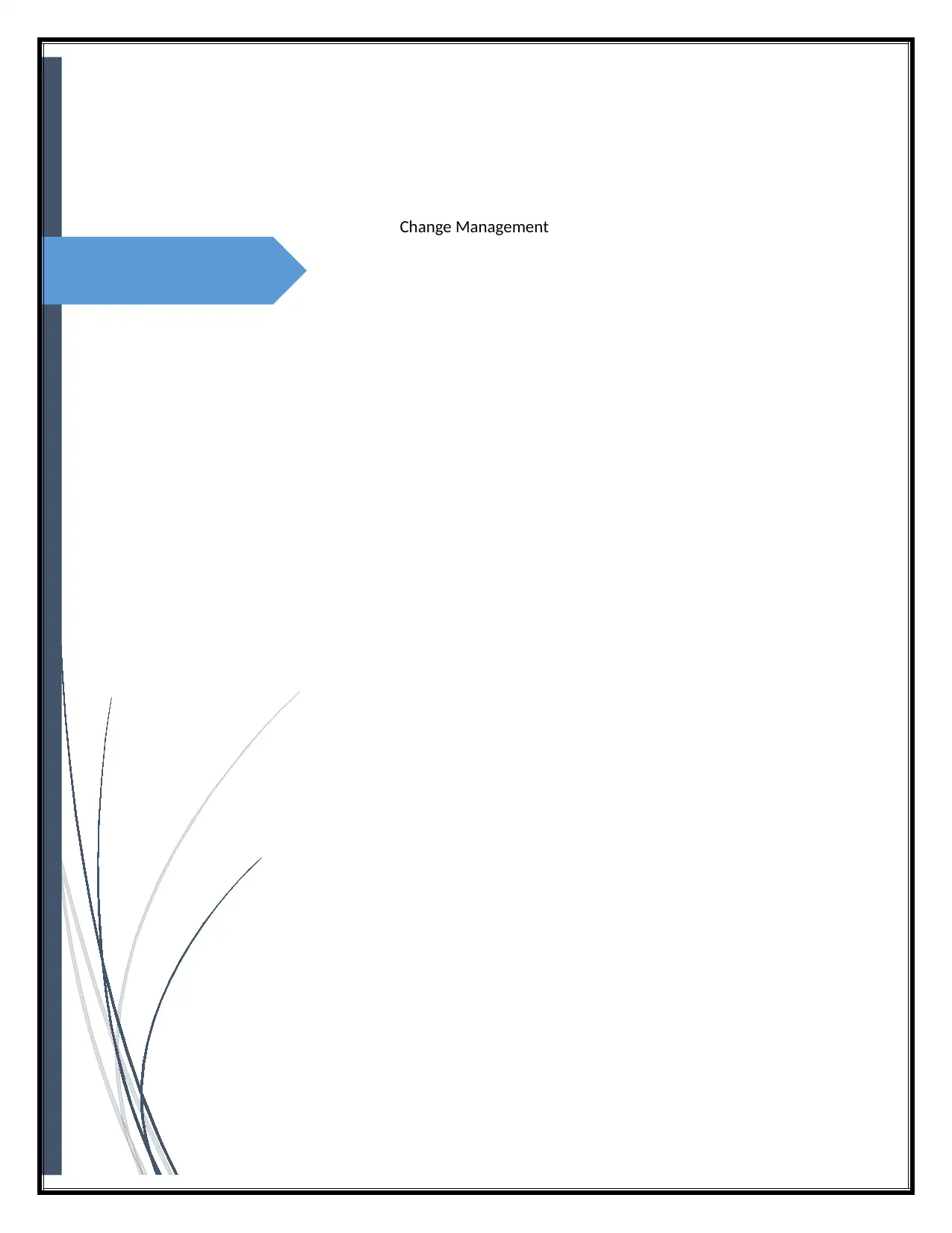
Change Management
Paraphrase This Document
Need a fresh take? Get an instant paraphrase of this document with our AI Paraphraser
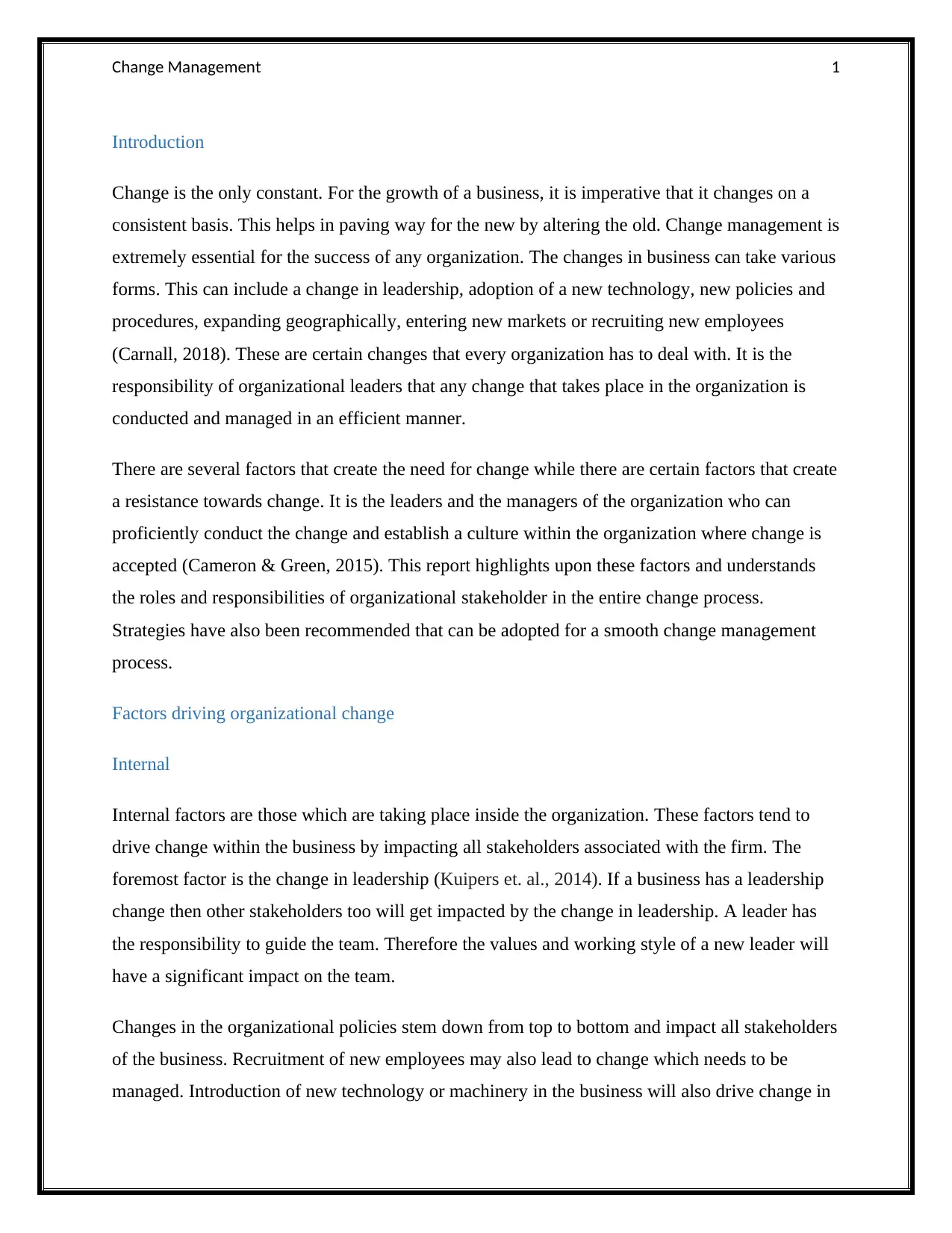
Change Management 1
Introduction
Change is the only constant. For the growth of a business, it is imperative that it changes on a
consistent basis. This helps in paving way for the new by altering the old. Change management is
extremely essential for the success of any organization. The changes in business can take various
forms. This can include a change in leadership, adoption of a new technology, new policies and
procedures, expanding geographically, entering new markets or recruiting new employees
(Carnall, 2018). These are certain changes that every organization has to deal with. It is the
responsibility of organizational leaders that any change that takes place in the organization is
conducted and managed in an efficient manner.
There are several factors that create the need for change while there are certain factors that create
a resistance towards change. It is the leaders and the managers of the organization who can
proficiently conduct the change and establish a culture within the organization where change is
accepted (Cameron & Green, 2015). This report highlights upon these factors and understands
the roles and responsibilities of organizational stakeholder in the entire change process.
Strategies have also been recommended that can be adopted for a smooth change management
process.
Factors driving organizational change
Internal
Internal factors are those which are taking place inside the organization. These factors tend to
drive change within the business by impacting all stakeholders associated with the firm. The
foremost factor is the change in leadership (Kuipers et. al., 2014). If a business has a leadership
change then other stakeholders too will get impacted by the change in leadership. A leader has
the responsibility to guide the team. Therefore the values and working style of a new leader will
have a significant impact on the team.
Changes in the organizational policies stem down from top to bottom and impact all stakeholders
of the business. Recruitment of new employees may also lead to change which needs to be
managed. Introduction of new technology or machinery in the business will also drive change in
Introduction
Change is the only constant. For the growth of a business, it is imperative that it changes on a
consistent basis. This helps in paving way for the new by altering the old. Change management is
extremely essential for the success of any organization. The changes in business can take various
forms. This can include a change in leadership, adoption of a new technology, new policies and
procedures, expanding geographically, entering new markets or recruiting new employees
(Carnall, 2018). These are certain changes that every organization has to deal with. It is the
responsibility of organizational leaders that any change that takes place in the organization is
conducted and managed in an efficient manner.
There are several factors that create the need for change while there are certain factors that create
a resistance towards change. It is the leaders and the managers of the organization who can
proficiently conduct the change and establish a culture within the organization where change is
accepted (Cameron & Green, 2015). This report highlights upon these factors and understands
the roles and responsibilities of organizational stakeholder in the entire change process.
Strategies have also been recommended that can be adopted for a smooth change management
process.
Factors driving organizational change
Internal
Internal factors are those which are taking place inside the organization. These factors tend to
drive change within the business by impacting all stakeholders associated with the firm. The
foremost factor is the change in leadership (Kuipers et. al., 2014). If a business has a leadership
change then other stakeholders too will get impacted by the change in leadership. A leader has
the responsibility to guide the team. Therefore the values and working style of a new leader will
have a significant impact on the team.
Changes in the organizational policies stem down from top to bottom and impact all stakeholders
of the business. Recruitment of new employees may also lead to change which needs to be
managed. Introduction of new technology or machinery in the business will also drive change in
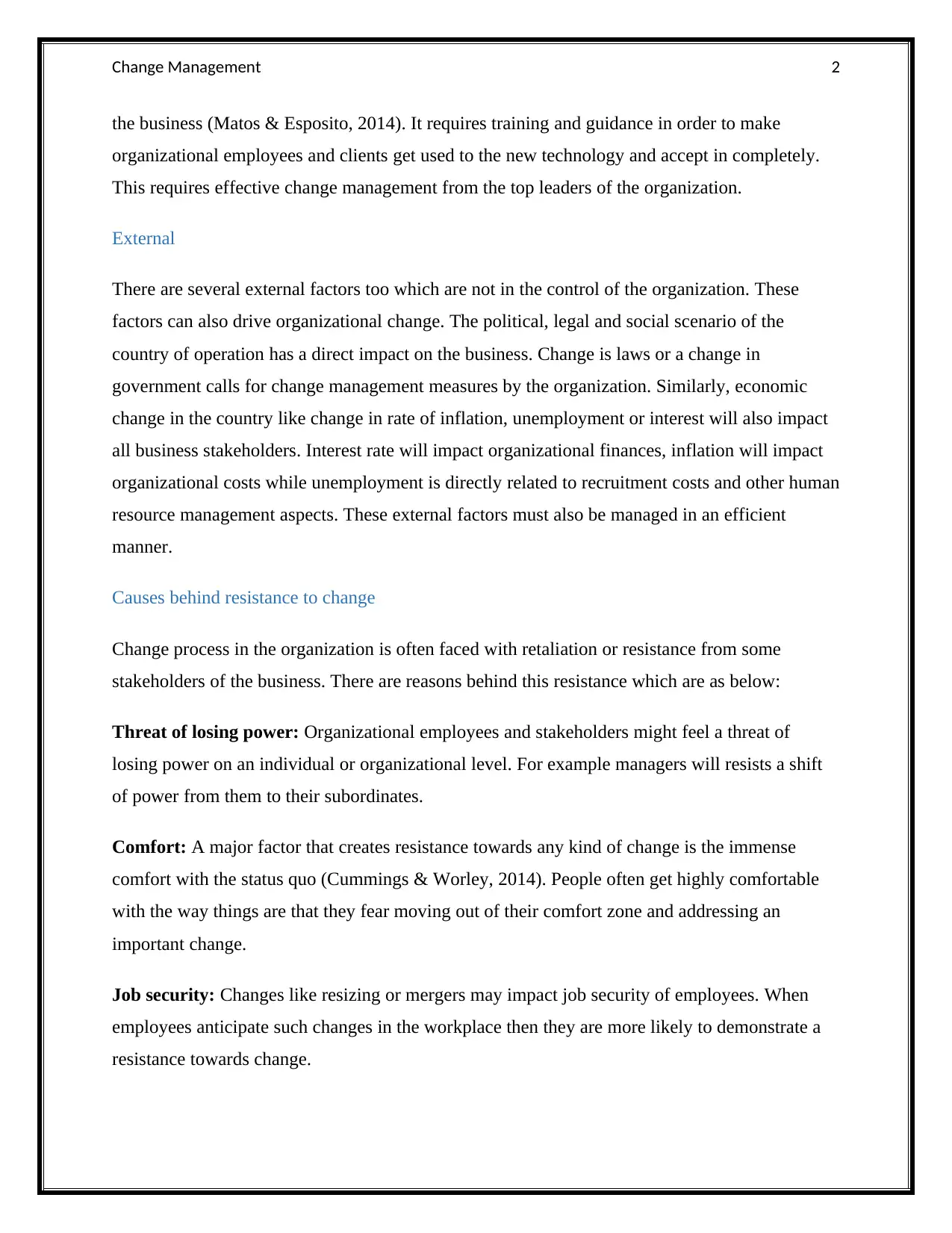
Change Management 2
the business (Matos & Esposito, 2014). It requires training and guidance in order to make
organizational employees and clients get used to the new technology and accept in completely.
This requires effective change management from the top leaders of the organization.
External
There are several external factors too which are not in the control of the organization. These
factors can also drive organizational change. The political, legal and social scenario of the
country of operation has a direct impact on the business. Change is laws or a change in
government calls for change management measures by the organization. Similarly, economic
change in the country like change in rate of inflation, unemployment or interest will also impact
all business stakeholders. Interest rate will impact organizational finances, inflation will impact
organizational costs while unemployment is directly related to recruitment costs and other human
resource management aspects. These external factors must also be managed in an efficient
manner.
Causes behind resistance to change
Change process in the organization is often faced with retaliation or resistance from some
stakeholders of the business. There are reasons behind this resistance which are as below:
Threat of losing power: Organizational employees and stakeholders might feel a threat of
losing power on an individual or organizational level. For example managers will resists a shift
of power from them to their subordinates.
Comfort: A major factor that creates resistance towards any kind of change is the immense
comfort with the status quo (Cummings & Worley, 2014). People often get highly comfortable
with the way things are that they fear moving out of their comfort zone and addressing an
important change.
Job security: Changes like resizing or mergers may impact job security of employees. When
employees anticipate such changes in the workplace then they are more likely to demonstrate a
resistance towards change.
the business (Matos & Esposito, 2014). It requires training and guidance in order to make
organizational employees and clients get used to the new technology and accept in completely.
This requires effective change management from the top leaders of the organization.
External
There are several external factors too which are not in the control of the organization. These
factors can also drive organizational change. The political, legal and social scenario of the
country of operation has a direct impact on the business. Change is laws or a change in
government calls for change management measures by the organization. Similarly, economic
change in the country like change in rate of inflation, unemployment or interest will also impact
all business stakeholders. Interest rate will impact organizational finances, inflation will impact
organizational costs while unemployment is directly related to recruitment costs and other human
resource management aspects. These external factors must also be managed in an efficient
manner.
Causes behind resistance to change
Change process in the organization is often faced with retaliation or resistance from some
stakeholders of the business. There are reasons behind this resistance which are as below:
Threat of losing power: Organizational employees and stakeholders might feel a threat of
losing power on an individual or organizational level. For example managers will resists a shift
of power from them to their subordinates.
Comfort: A major factor that creates resistance towards any kind of change is the immense
comfort with the status quo (Cummings & Worley, 2014). People often get highly comfortable
with the way things are that they fear moving out of their comfort zone and addressing an
important change.
Job security: Changes like resizing or mergers may impact job security of employees. When
employees anticipate such changes in the workplace then they are more likely to demonstrate a
resistance towards change.
⊘ This is a preview!⊘
Do you want full access?
Subscribe today to unlock all pages.

Trusted by 1+ million students worldwide
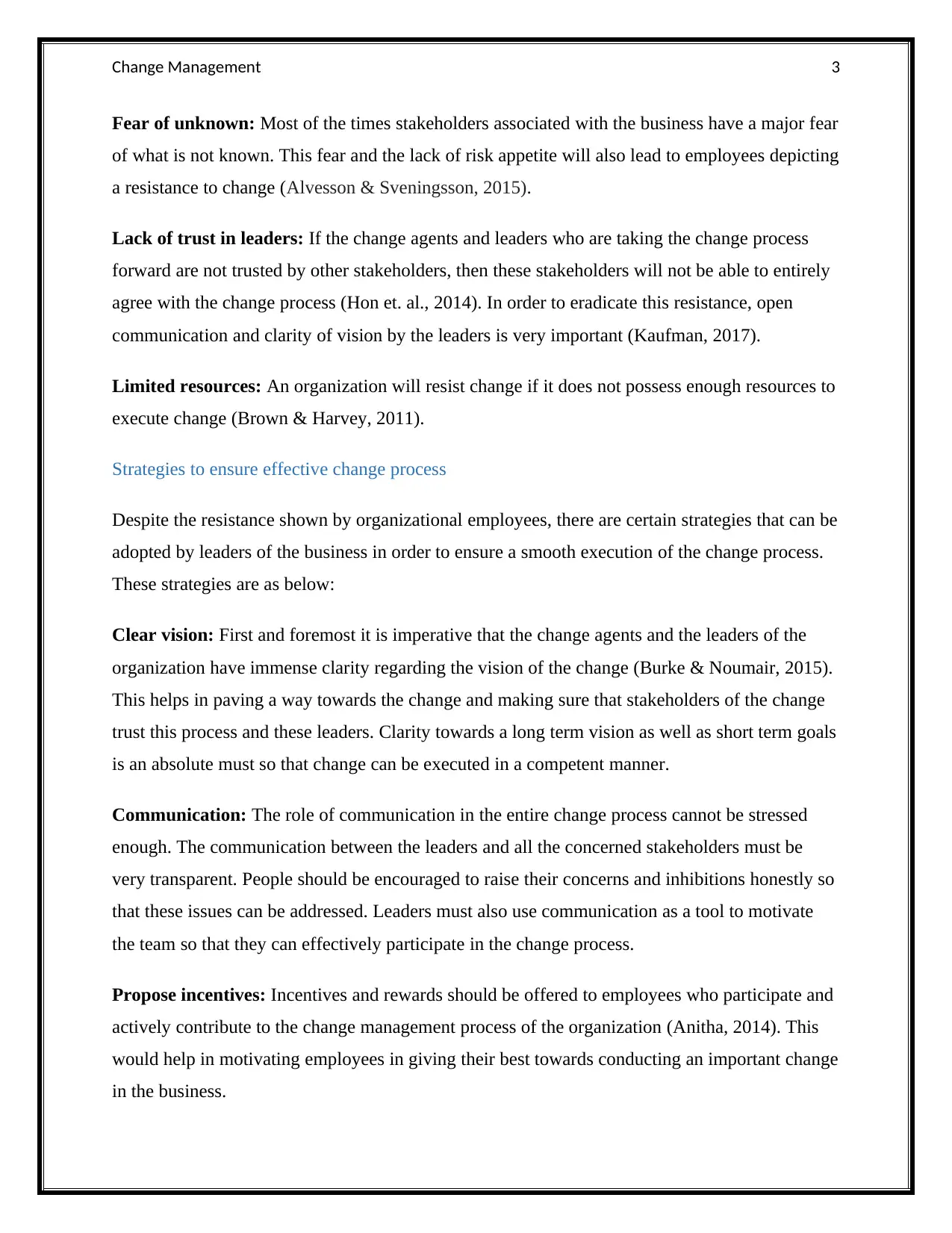
Change Management 3
Fear of unknown: Most of the times stakeholders associated with the business have a major fear
of what is not known. This fear and the lack of risk appetite will also lead to employees depicting
a resistance to change (Alvesson & Sveningsson, 2015).
Lack of trust in leaders: If the change agents and leaders who are taking the change process
forward are not trusted by other stakeholders, then these stakeholders will not be able to entirely
agree with the change process (Hon et. al., 2014). In order to eradicate this resistance, open
communication and clarity of vision by the leaders is very important (Kaufman, 2017).
Limited resources: An organization will resist change if it does not possess enough resources to
execute change (Brown & Harvey, 2011).
Strategies to ensure effective change process
Despite the resistance shown by organizational employees, there are certain strategies that can be
adopted by leaders of the business in order to ensure a smooth execution of the change process.
These strategies are as below:
Clear vision: First and foremost it is imperative that the change agents and the leaders of the
organization have immense clarity regarding the vision of the change (Burke & Noumair, 2015).
This helps in paving a way towards the change and making sure that stakeholders of the change
trust this process and these leaders. Clarity towards a long term vision as well as short term goals
is an absolute must so that change can be executed in a competent manner.
Communication: The role of communication in the entire change process cannot be stressed
enough. The communication between the leaders and all the concerned stakeholders must be
very transparent. People should be encouraged to raise their concerns and inhibitions honestly so
that these issues can be addressed. Leaders must also use communication as a tool to motivate
the team so that they can effectively participate in the change process.
Propose incentives: Incentives and rewards should be offered to employees who participate and
actively contribute to the change management process of the organization (Anitha, 2014). This
would help in motivating employees in giving their best towards conducting an important change
in the business.
Fear of unknown: Most of the times stakeholders associated with the business have a major fear
of what is not known. This fear and the lack of risk appetite will also lead to employees depicting
a resistance to change (Alvesson & Sveningsson, 2015).
Lack of trust in leaders: If the change agents and leaders who are taking the change process
forward are not trusted by other stakeholders, then these stakeholders will not be able to entirely
agree with the change process (Hon et. al., 2014). In order to eradicate this resistance, open
communication and clarity of vision by the leaders is very important (Kaufman, 2017).
Limited resources: An organization will resist change if it does not possess enough resources to
execute change (Brown & Harvey, 2011).
Strategies to ensure effective change process
Despite the resistance shown by organizational employees, there are certain strategies that can be
adopted by leaders of the business in order to ensure a smooth execution of the change process.
These strategies are as below:
Clear vision: First and foremost it is imperative that the change agents and the leaders of the
organization have immense clarity regarding the vision of the change (Burke & Noumair, 2015).
This helps in paving a way towards the change and making sure that stakeholders of the change
trust this process and these leaders. Clarity towards a long term vision as well as short term goals
is an absolute must so that change can be executed in a competent manner.
Communication: The role of communication in the entire change process cannot be stressed
enough. The communication between the leaders and all the concerned stakeholders must be
very transparent. People should be encouraged to raise their concerns and inhibitions honestly so
that these issues can be addressed. Leaders must also use communication as a tool to motivate
the team so that they can effectively participate in the change process.
Propose incentives: Incentives and rewards should be offered to employees who participate and
actively contribute to the change management process of the organization (Anitha, 2014). This
would help in motivating employees in giving their best towards conducting an important change
in the business.
Paraphrase This Document
Need a fresh take? Get an instant paraphrase of this document with our AI Paraphraser
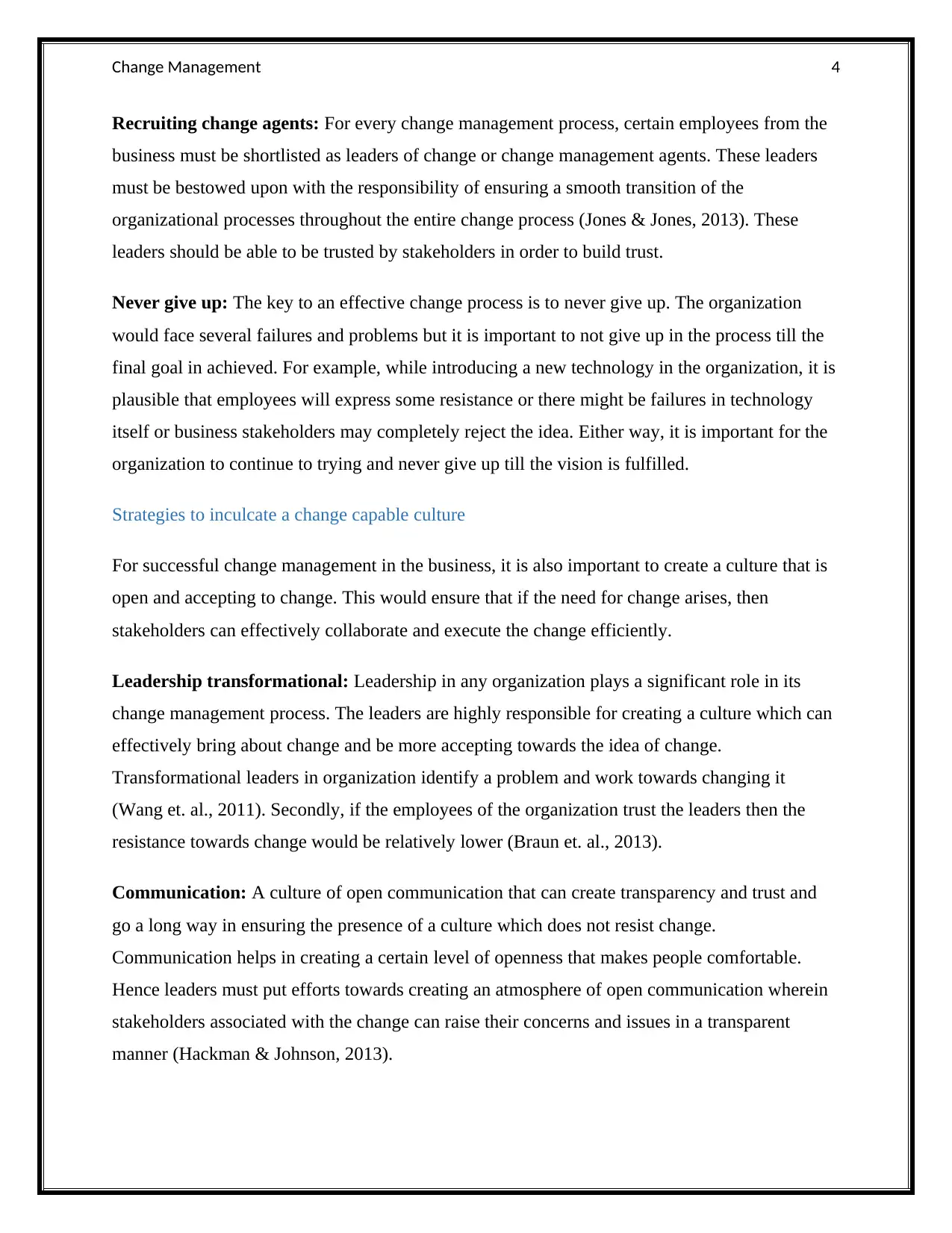
Change Management 4
Recruiting change agents: For every change management process, certain employees from the
business must be shortlisted as leaders of change or change management agents. These leaders
must be bestowed upon with the responsibility of ensuring a smooth transition of the
organizational processes throughout the entire change process (Jones & Jones, 2013). These
leaders should be able to be trusted by stakeholders in order to build trust.
Never give up: The key to an effective change process is to never give up. The organization
would face several failures and problems but it is important to not give up in the process till the
final goal in achieved. For example, while introducing a new technology in the organization, it is
plausible that employees will express some resistance or there might be failures in technology
itself or business stakeholders may completely reject the idea. Either way, it is important for the
organization to continue to trying and never give up till the vision is fulfilled.
Strategies to inculcate a change capable culture
For successful change management in the business, it is also important to create a culture that is
open and accepting to change. This would ensure that if the need for change arises, then
stakeholders can effectively collaborate and execute the change efficiently.
Leadership transformational: Leadership in any organization plays a significant role in its
change management process. The leaders are highly responsible for creating a culture which can
effectively bring about change and be more accepting towards the idea of change.
Transformational leaders in organization identify a problem and work towards changing it
(Wang et. al., 2011). Secondly, if the employees of the organization trust the leaders then the
resistance towards change would be relatively lower (Braun et. al., 2013).
Communication: A culture of open communication that can create transparency and trust and
go a long way in ensuring the presence of a culture which does not resist change.
Communication helps in creating a certain level of openness that makes people comfortable.
Hence leaders must put efforts towards creating an atmosphere of open communication wherein
stakeholders associated with the change can raise their concerns and issues in a transparent
manner (Hackman & Johnson, 2013).
Recruiting change agents: For every change management process, certain employees from the
business must be shortlisted as leaders of change or change management agents. These leaders
must be bestowed upon with the responsibility of ensuring a smooth transition of the
organizational processes throughout the entire change process (Jones & Jones, 2013). These
leaders should be able to be trusted by stakeholders in order to build trust.
Never give up: The key to an effective change process is to never give up. The organization
would face several failures and problems but it is important to not give up in the process till the
final goal in achieved. For example, while introducing a new technology in the organization, it is
plausible that employees will express some resistance or there might be failures in technology
itself or business stakeholders may completely reject the idea. Either way, it is important for the
organization to continue to trying and never give up till the vision is fulfilled.
Strategies to inculcate a change capable culture
For successful change management in the business, it is also important to create a culture that is
open and accepting to change. This would ensure that if the need for change arises, then
stakeholders can effectively collaborate and execute the change efficiently.
Leadership transformational: Leadership in any organization plays a significant role in its
change management process. The leaders are highly responsible for creating a culture which can
effectively bring about change and be more accepting towards the idea of change.
Transformational leaders in organization identify a problem and work towards changing it
(Wang et. al., 2011). Secondly, if the employees of the organization trust the leaders then the
resistance towards change would be relatively lower (Braun et. al., 2013).
Communication: A culture of open communication that can create transparency and trust and
go a long way in ensuring the presence of a culture which does not resist change.
Communication helps in creating a certain level of openness that makes people comfortable.
Hence leaders must put efforts towards creating an atmosphere of open communication wherein
stakeholders associated with the change can raise their concerns and issues in a transparent
manner (Hackman & Johnson, 2013).
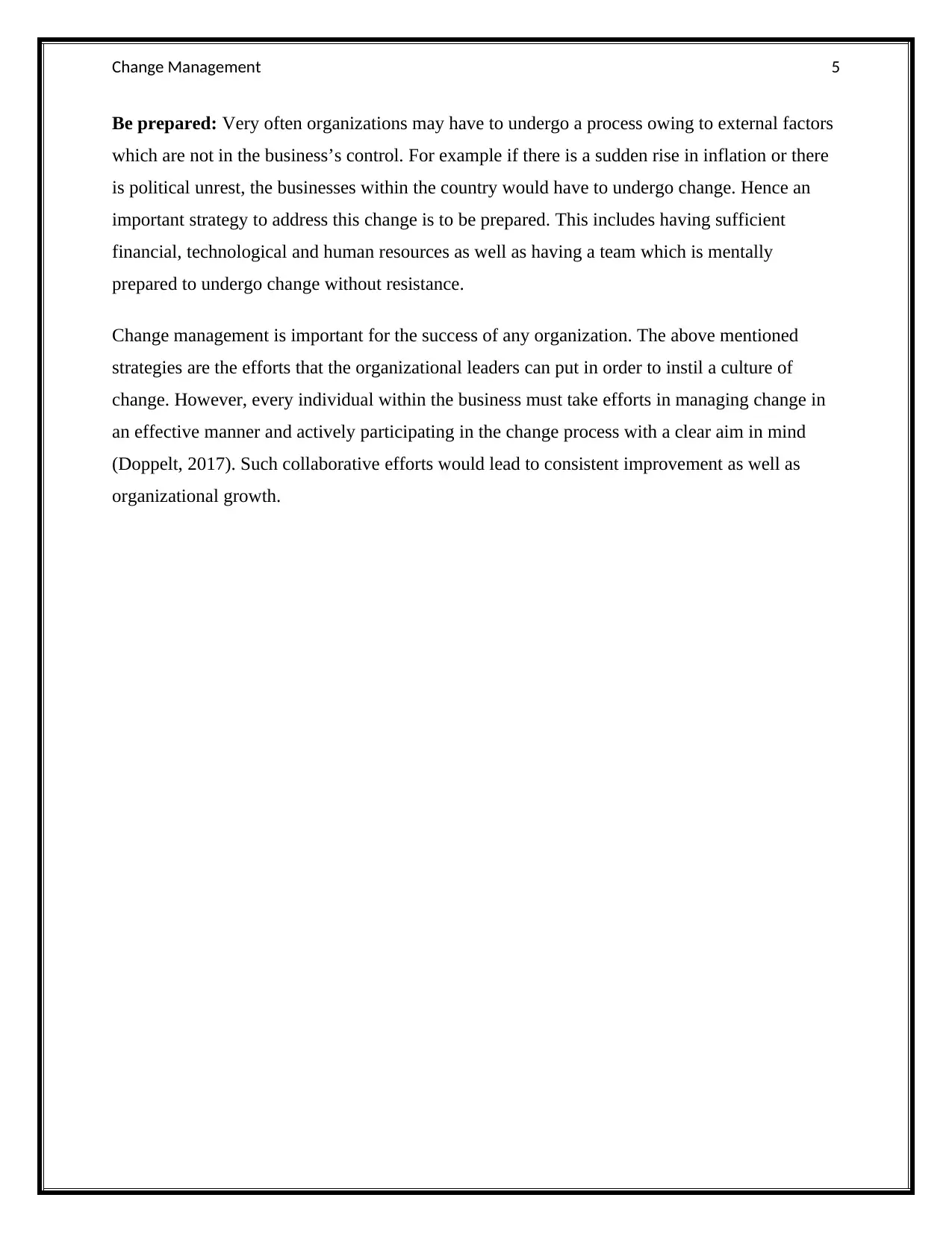
Change Management 5
Be prepared: Very often organizations may have to undergo a process owing to external factors
which are not in the business’s control. For example if there is a sudden rise in inflation or there
is political unrest, the businesses within the country would have to undergo change. Hence an
important strategy to address this change is to be prepared. This includes having sufficient
financial, technological and human resources as well as having a team which is mentally
prepared to undergo change without resistance.
Change management is important for the success of any organization. The above mentioned
strategies are the efforts that the organizational leaders can put in order to instil a culture of
change. However, every individual within the business must take efforts in managing change in
an effective manner and actively participating in the change process with a clear aim in mind
(Doppelt, 2017). Such collaborative efforts would lead to consistent improvement as well as
organizational growth.
Be prepared: Very often organizations may have to undergo a process owing to external factors
which are not in the business’s control. For example if there is a sudden rise in inflation or there
is political unrest, the businesses within the country would have to undergo change. Hence an
important strategy to address this change is to be prepared. This includes having sufficient
financial, technological and human resources as well as having a team which is mentally
prepared to undergo change without resistance.
Change management is important for the success of any organization. The above mentioned
strategies are the efforts that the organizational leaders can put in order to instil a culture of
change. However, every individual within the business must take efforts in managing change in
an effective manner and actively participating in the change process with a clear aim in mind
(Doppelt, 2017). Such collaborative efforts would lead to consistent improvement as well as
organizational growth.
⊘ This is a preview!⊘
Do you want full access?
Subscribe today to unlock all pages.

Trusted by 1+ million students worldwide
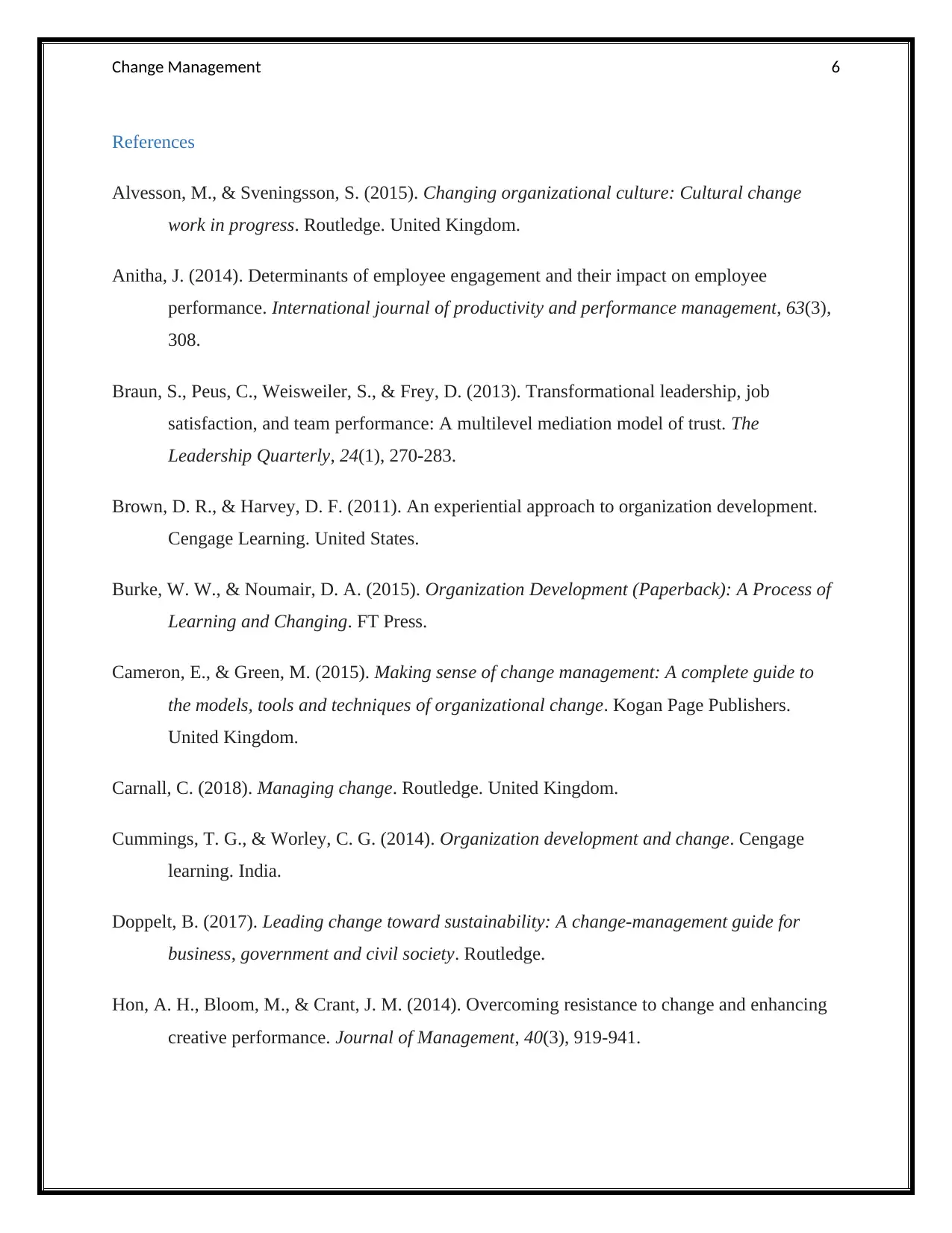
Change Management 6
References
Alvesson, M., & Sveningsson, S. (2015). Changing organizational culture: Cultural change
work in progress. Routledge. United Kingdom.
Anitha, J. (2014). Determinants of employee engagement and their impact on employee
performance. International journal of productivity and performance management, 63(3),
308.
Braun, S., Peus, C., Weisweiler, S., & Frey, D. (2013). Transformational leadership, job
satisfaction, and team performance: A multilevel mediation model of trust. The
Leadership Quarterly, 24(1), 270-283.
Brown, D. R., & Harvey, D. F. (2011). An experiential approach to organization development.
Cengage Learning. United States.
Burke, W. W., & Noumair, D. A. (2015). Organization Development (Paperback): A Process of
Learning and Changing. FT Press.
Cameron, E., & Green, M. (2015). Making sense of change management: A complete guide to
the models, tools and techniques of organizational change. Kogan Page Publishers.
United Kingdom.
Carnall, C. (2018). Managing change. Routledge. United Kingdom.
Cummings, T. G., & Worley, C. G. (2014). Organization development and change. Cengage
learning. India.
Doppelt, B. (2017). Leading change toward sustainability: A change-management guide for
business, government and civil society. Routledge.
Hon, A. H., Bloom, M., & Crant, J. M. (2014). Overcoming resistance to change and enhancing
creative performance. Journal of Management, 40(3), 919-941.
References
Alvesson, M., & Sveningsson, S. (2015). Changing organizational culture: Cultural change
work in progress. Routledge. United Kingdom.
Anitha, J. (2014). Determinants of employee engagement and their impact on employee
performance. International journal of productivity and performance management, 63(3),
308.
Braun, S., Peus, C., Weisweiler, S., & Frey, D. (2013). Transformational leadership, job
satisfaction, and team performance: A multilevel mediation model of trust. The
Leadership Quarterly, 24(1), 270-283.
Brown, D. R., & Harvey, D. F. (2011). An experiential approach to organization development.
Cengage Learning. United States.
Burke, W. W., & Noumair, D. A. (2015). Organization Development (Paperback): A Process of
Learning and Changing. FT Press.
Cameron, E., & Green, M. (2015). Making sense of change management: A complete guide to
the models, tools and techniques of organizational change. Kogan Page Publishers.
United Kingdom.
Carnall, C. (2018). Managing change. Routledge. United Kingdom.
Cummings, T. G., & Worley, C. G. (2014). Organization development and change. Cengage
learning. India.
Doppelt, B. (2017). Leading change toward sustainability: A change-management guide for
business, government and civil society. Routledge.
Hon, A. H., Bloom, M., & Crant, J. M. (2014). Overcoming resistance to change and enhancing
creative performance. Journal of Management, 40(3), 919-941.
Paraphrase This Document
Need a fresh take? Get an instant paraphrase of this document with our AI Paraphraser
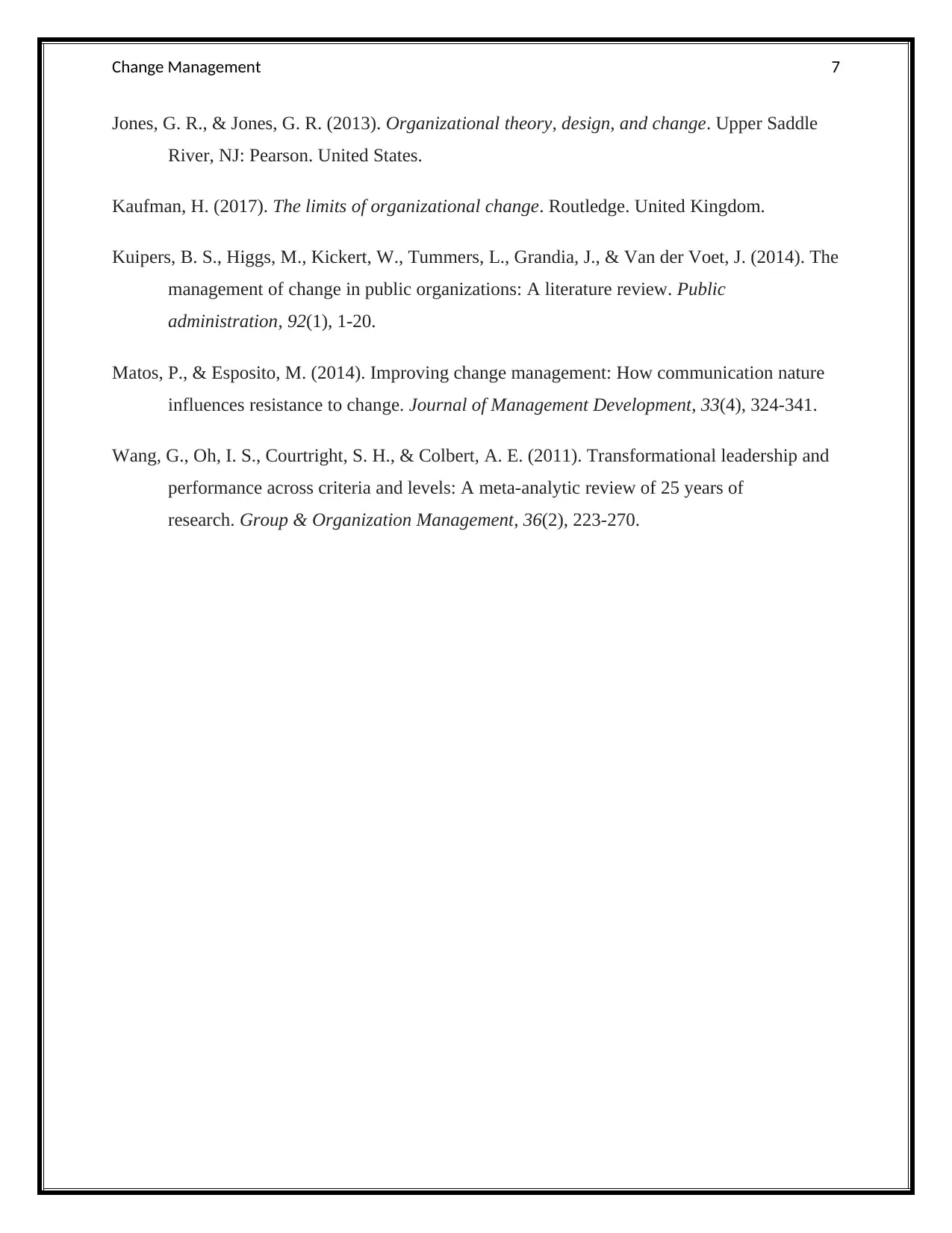
Change Management 7
Jones, G. R., & Jones, G. R. (2013). Organizational theory, design, and change. Upper Saddle
River, NJ: Pearson. United States.
Kaufman, H. (2017). The limits of organizational change. Routledge. United Kingdom.
Kuipers, B. S., Higgs, M., Kickert, W., Tummers, L., Grandia, J., & Van der Voet, J. (2014). The
management of change in public organizations: A literature review. Public
administration, 92(1), 1-20.
Matos, P., & Esposito, M. (2014). Improving change management: How communication nature
influences resistance to change. Journal of Management Development, 33(4), 324-341.
Wang, G., Oh, I. S., Courtright, S. H., & Colbert, A. E. (2011). Transformational leadership and
performance across criteria and levels: A meta-analytic review of 25 years of
research. Group & Organization Management, 36(2), 223-270.
Jones, G. R., & Jones, G. R. (2013). Organizational theory, design, and change. Upper Saddle
River, NJ: Pearson. United States.
Kaufman, H. (2017). The limits of organizational change. Routledge. United Kingdom.
Kuipers, B. S., Higgs, M., Kickert, W., Tummers, L., Grandia, J., & Van der Voet, J. (2014). The
management of change in public organizations: A literature review. Public
administration, 92(1), 1-20.
Matos, P., & Esposito, M. (2014). Improving change management: How communication nature
influences resistance to change. Journal of Management Development, 33(4), 324-341.
Wang, G., Oh, I. S., Courtright, S. H., & Colbert, A. E. (2011). Transformational leadership and
performance across criteria and levels: A meta-analytic review of 25 years of
research. Group & Organization Management, 36(2), 223-270.
1 out of 8
Related Documents
Your All-in-One AI-Powered Toolkit for Academic Success.
+13062052269
info@desklib.com
Available 24*7 on WhatsApp / Email
![[object Object]](/_next/static/media/star-bottom.7253800d.svg)
Unlock your academic potential
Copyright © 2020–2025 A2Z Services. All Rights Reserved. Developed and managed by ZUCOL.




